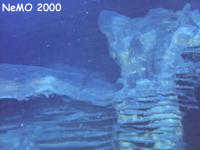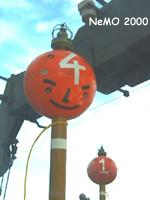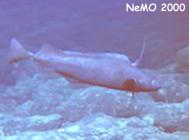| |
Science
Report:
ROPOS dive 554
completed the Imagenex survey that was started on dive
546 at the southern end of the 1998 eruptive area. At this location,
4 miles south of Marker 33, a mound of pillow lavas was erupted which
piled up to a thickness of 25 meters in places, enough of a depth difference
to be detected in before-and-after bathymetric surveys. After collecting
the Imagenex data, a geologic traverse was made on the bottom to examine
some of the features revealed during the first part of the survey. ROPOS
visited the large 1998 eruptive fissure to the north of the pillow mound
which was 20 meters wide and 3 meters deep, and collapse pits in the middle
of the flow with spectacular drain-out features in them (photo right).
After the dive we recovered
the acoustic transponders that allowed us to navigate ROPOS in that southern
area. Next, we transited up to Axial's north rift zone for the first time
during NeMO 2000 (the 1998 eruption was on Axial's south rift zone) and
we lowered four extensometer
instruments to the seafloor in an elevator mooring. ROPOS then positioned
the instruments across the rift zone during dive 555, where they will
precisely measure the distance across the rift over the next year. These
same instruments measured deformation at this site due to the 1998 eruption.
We're hoping to get two
more dives in before we have to leave Axial early Monday morning.
|
|

Lava pillar
at edge of drainage pit in collapsed area. Beautiful area discovered
on geologic traverse trhough the new 1998 lavas. Pillars are along edge
of a large fissure area.

"Happy" extensometer instruments deployed on Axial volcano's
north rift zone.

Deep-water fish spotted
during geologic traverse. Fish is above older pillow lavas and in the
background are the new, glassy lavas.
|
|

